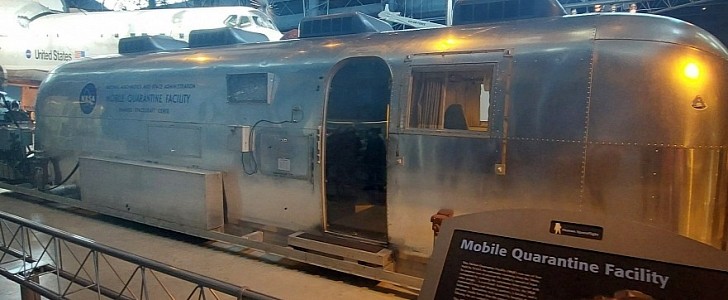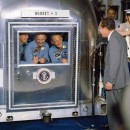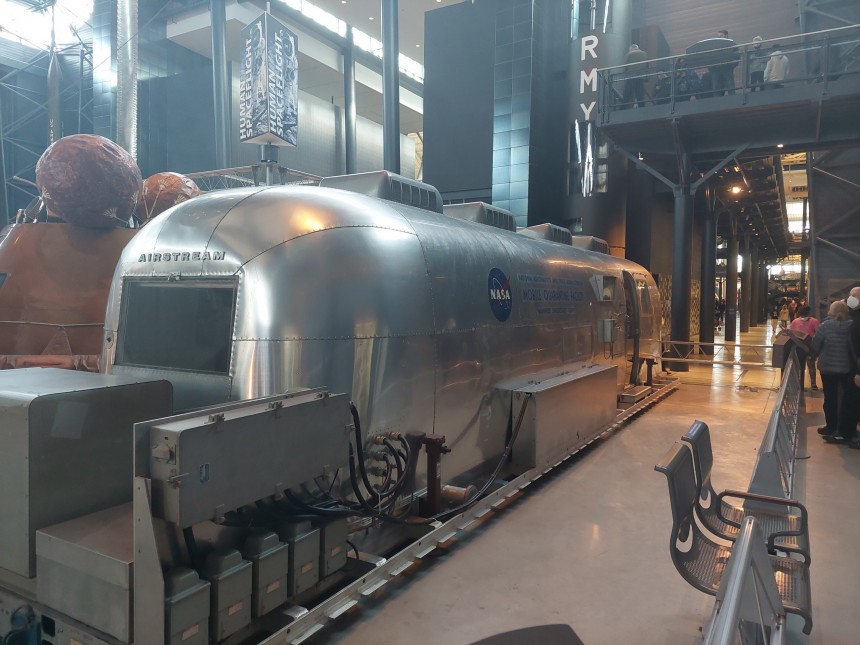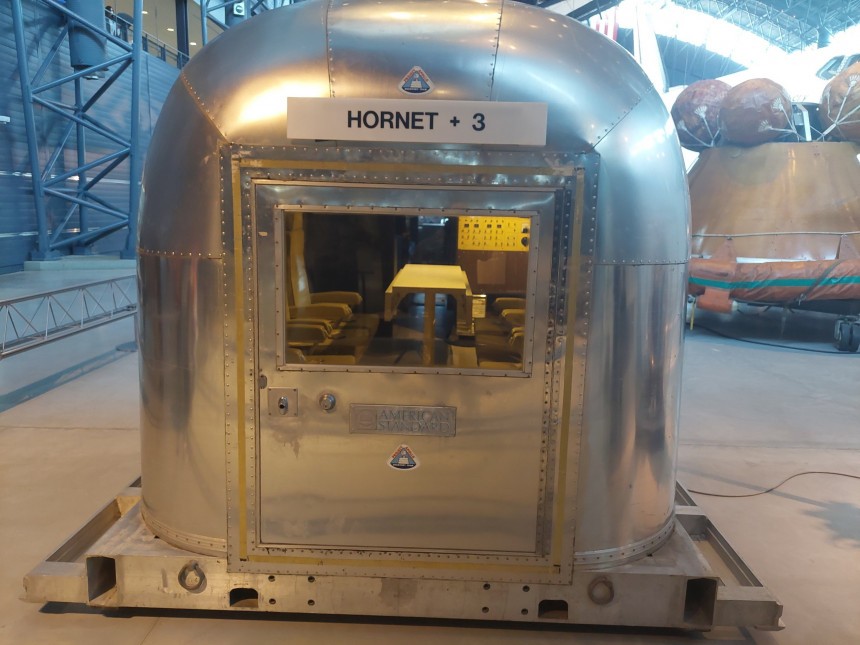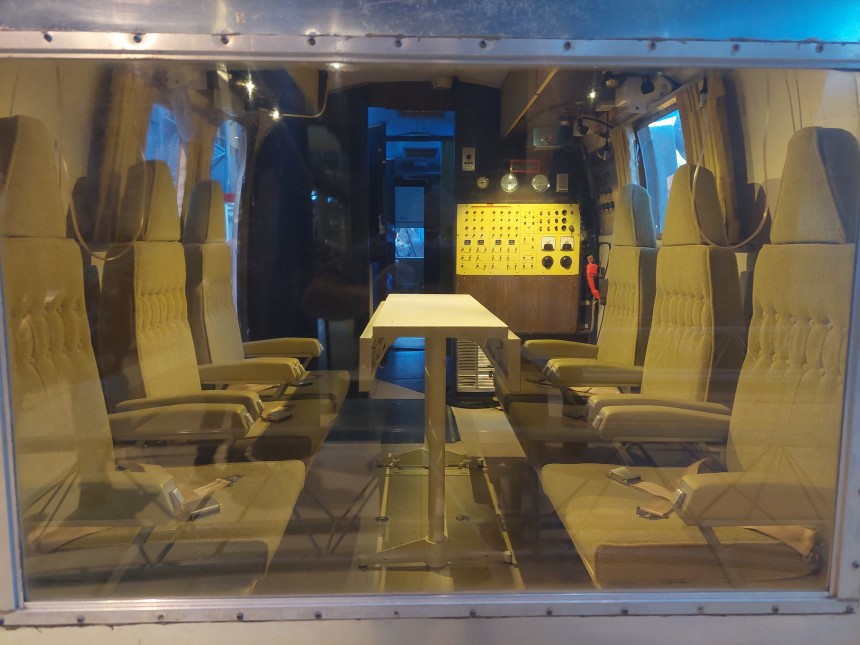It's RV Month here at autoevolution. Though some of us among the writing staff don't have much interest in motorhomes, camper trailers, and all things mobile living, we can at least make exceptions when one's built under extraordinary circumstances.
Without going into a dissertation about the definition of extraordinary circumstances, we think this converted Airstream RV camper trailer turned into a mobile quarantine facility for Apollo astronauts surely qualifies. It may not be a Saturn V rocket or a fully-fledged lunar landing vehicle. But it sure as heck makes for an interesting story in this month celebrating the history of recreational vehicles.
Let us paint the picture for you. It's July 24th, 1969, around 900 miles southwest of Hawaii. After humanity's first voyage to the surface of another heavenly body, Neil Armstrong, Buzz Aldrin, and Michael Collins have just splashed down in the Pacific Ocean with Apollo 11's Command Module Columbia. They're mentally tired, physically fatigued, and parts of their space suits are still covered in moon dust.
One would think the first place the three American heroes went off to after the Navy scooped them out of the water would be straight to New York City for a well-deserved ticker-tape parade. But you'd be dead wrong. As bonkers as it may sound, NASA and the Department of Defense were concerned about something unforeseen, hitching a ride back home with Apollo 11's crew.
That's right, more than anything else, NASA's most pressing concern was potentially bringing home some sort of alien life form from the surface of the Moon back home to mother Earth. If that sounds like some kind of sci-fi movie plot, we refer you to the 2017 horror film Life, in which that's pretty much the plot of the whole movie in a nutshell.
It's almost like they were taking inspiration from someplace. In any case, even the minute possibility of some form of "Moon Bug" showing up on any of the astronauts from this historic mission was not one NASA was ready to take lightly. Instead, Collins, Aldrin, and Armstrong were forced to be rubbed down in an interesting-sounding solution called sodium hypochlorite.
The idea was that the stuff would kill any lunar microbes that hypothetically threatened to spread across the planet if they escaped. With that in mind, the first place the crew of Apollo 11 embarked after being scooped up from the ocean was the deck of the World War II veteran aircraft carrier USS Hornet.
From there, the crew walked a distance of around 30 feet (9.1 m) to where a truly special and unique RV was waiting for them in the Hornet's main hangar. It'd be the last time they'd see fresh air for at least 21 days. It was the Airstream Mobile Quarantine Facility (MQF).
That was made by the very same makers of the iconic trailer camper and recreational vehicles since the early 1920s. But of all their glamorous models, perhaps no other airstream was of any larger prestige or historical significance than what's become known by its nickname, the Apollo Quarantine Trailer.
This was to be the new home for the crew of every completed Apollo mission for the next three weeks after their fiery return to Earth. Inside would be all the necessities and requirements any human being would need to live and survive inside for the entire duration of their mildly ridiculous government-mandated quarantine.
At the far right end of the trailer, a six-person crew quarter consisted of one long table with three chairs per side, seemingly ripped out of an airliner. These seats were occupied by the three astronauts and a crew of doctors, technicians, and scientists who could quarantine along with the crew.
Moving down towards the center of the vehicle, we find the kitchen area, complete with running water and a microwave oven to prepare pre-packaged food brought in from the outside and heated on plastic serving trays. Finishing up on the left-hand side, a set of bunks seemingly taken straight from a military barracks was the astronauts' only sleeping arrangement for the three days the MQF was in transit from their landing site to Pearl Harbor.
There were also ample accommodations for climate controls and HVAC systems for crew comfort, alongside a capable communications array that allowed Apollo crews to talk with their family and friends. Four Airstream MQFs were manufactured during the Apollo program.
After NASA determined the idea of a Moon germ is as preposterous as we think it is, the program was canceled. Today, you can find the existing MQFs from Apollo 11 through 14 at museums across the U.S. We were privileged enough to take a trip to the National Air and Space Museum's Steven F. Udvar-Hazy Center in Chantilly, Virginia, a few months ago and see the very first MQF used in the historic Apollo 11 mission up close and in person.
Safe to say, it was one of the coolest exhibits in the whole building. We leave you with this hilarious photo of President Richard Nixon greeting the Apollo 11 crew through the MQF's window like a trio of caged puppies. How this isn't a meme or an NFT yet, we have no idea.
Check back soon for more from RV month here on autoevolution.
Let us paint the picture for you. It's July 24th, 1969, around 900 miles southwest of Hawaii. After humanity's first voyage to the surface of another heavenly body, Neil Armstrong, Buzz Aldrin, and Michael Collins have just splashed down in the Pacific Ocean with Apollo 11's Command Module Columbia. They're mentally tired, physically fatigued, and parts of their space suits are still covered in moon dust.
One would think the first place the three American heroes went off to after the Navy scooped them out of the water would be straight to New York City for a well-deserved ticker-tape parade. But you'd be dead wrong. As bonkers as it may sound, NASA and the Department of Defense were concerned about something unforeseen, hitching a ride back home with Apollo 11's crew.
That's right, more than anything else, NASA's most pressing concern was potentially bringing home some sort of alien life form from the surface of the Moon back home to mother Earth. If that sounds like some kind of sci-fi movie plot, we refer you to the 2017 horror film Life, in which that's pretty much the plot of the whole movie in a nutshell.
The idea was that the stuff would kill any lunar microbes that hypothetically threatened to spread across the planet if they escaped. With that in mind, the first place the crew of Apollo 11 embarked after being scooped up from the ocean was the deck of the World War II veteran aircraft carrier USS Hornet.
From there, the crew walked a distance of around 30 feet (9.1 m) to where a truly special and unique RV was waiting for them in the Hornet's main hangar. It'd be the last time they'd see fresh air for at least 21 days. It was the Airstream Mobile Quarantine Facility (MQF).
That was made by the very same makers of the iconic trailer camper and recreational vehicles since the early 1920s. But of all their glamorous models, perhaps no other airstream was of any larger prestige or historical significance than what's become known by its nickname, the Apollo Quarantine Trailer.
At the far right end of the trailer, a six-person crew quarter consisted of one long table with three chairs per side, seemingly ripped out of an airliner. These seats were occupied by the three astronauts and a crew of doctors, technicians, and scientists who could quarantine along with the crew.
Moving down towards the center of the vehicle, we find the kitchen area, complete with running water and a microwave oven to prepare pre-packaged food brought in from the outside and heated on plastic serving trays. Finishing up on the left-hand side, a set of bunks seemingly taken straight from a military barracks was the astronauts' only sleeping arrangement for the three days the MQF was in transit from their landing site to Pearl Harbor.
There were also ample accommodations for climate controls and HVAC systems for crew comfort, alongside a capable communications array that allowed Apollo crews to talk with their family and friends. Four Airstream MQFs were manufactured during the Apollo program.
Safe to say, it was one of the coolest exhibits in the whole building. We leave you with this hilarious photo of President Richard Nixon greeting the Apollo 11 crew through the MQF's window like a trio of caged puppies. How this isn't a meme or an NFT yet, we have no idea.
